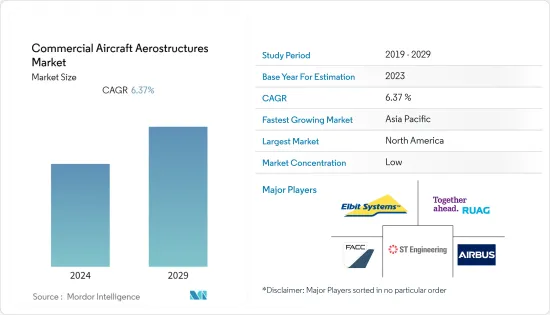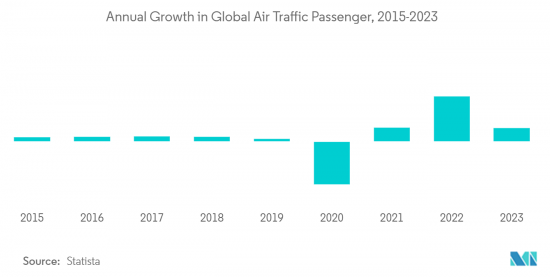
|
市場調査レポート
商品コード
1405076
民間航空機の航空構造-市場シェア分析、産業動向と統計、2024~2029年の成長予測Commercial Aircraft Aerostructures - Market Share Analysis, Industry Trends & Statistics, Growth Forecasts 2024 - 2029 |
||||||
カスタマイズ可能
適宜更新あり
|
|||||||
| 民間航空機の航空構造-市場シェア分析、産業動向と統計、2024~2029年の成長予測 |
|
出版日: 2024年01月04日
発行: Mordor Intelligence
ページ情報: 英文 110 Pages
納期: 2~3営業日
|
- 全表示
- 概要
- 目次
民間航空機の航空構造市場は、2024年に573億8,000万米ドルと評価され、予測期間中のCAGRは6.37%を記録し、2029年には781億2,000万米ドルに達すると予測されています。

航空機の航空構造市場の成長の主要要因は、世界中で民間航空機の納入が増加していることです。民間航空業界では、新たに導入される航空機の数が大幅に増加しました。近年、旅客がよりフレキシブルになったことが、世界の航空構造市場の成長を支えています。複合材料やその他の先端材料の航空構造への使用は、航空機の設計を根本的に変えることにつながった。複合材料固有の高い強度対重量比は大幅な軽量化をもたらし、航空機の燃費効率を向上させました。
市場の成長は、航空安全に関する政府の厳格な規則とともに、国内外レベルでの観光客の増加にも起因しています。この分野における技術革新、航空業界における研究開発投資の増加、先進的な製品群を開発するための市場参入企業の努力の高まりが、業界拡大に牽引力を加えています。積層造形やAFP(Automated Fiber Placement:繊維自動配置)技術などの新技術は、複雑な部品設計に先端材料を組み込む範囲を拡大する一方で、航空機のターンアラウンドタイム(TAT)を短縮しています。しかし、航空分野の報酬範囲は、原材料価格の変動によって妨げられています。
民間航空機の航空構造市場の動向
旅客輸送量の増加が新世代航空機の調達を後押し
世界の旅客輸送量の大幅な増加により、航空会社は新世代の航空機の調達活動を開始し、確定発注を行った。2022年、Airbusは676機の民間航空機を納入し、ボーイングは480機を納入しました。航空機OEMは、受注残を減らし、航空会社への納期厳守を確実にするため、サプライチェーンを継続的に磨いています。2022年にはいくつかの新規発注があり、関連する航空構造メーカーやインテグレーターの生産能力強化を後押ししました。例えば、2023年6月、Indigo(インド)はパリ航空ショーでAirbus A320neoファミリーを500機発注しました。
同様に、Air India(インド)はAirbus機250機とBoeing機220機(700億米ドル相当)の新規購入契約に調印しました。Air Indiaの発注には、Airbusから34機のA350-1000と6機のA350-900、Boeingから20機のB787ドリームライナー、10機のB777Xを含む70機のワイドボディ機が含まれます。また、Airbus A320neo型機140機、Airbus A321neo型機70機、Boeing B737 MAX型ナローボディ機190機も含まれています。また、50機のB737 MAXと20機のB787ドリームライナーを含む70機をBoeingから追加購入するオプションにも調印しました。このような調達注文は、予測期間中の市場参入企業の事業展望を促進すると思われます。

予測期間中、アジア太平洋が最も高いCAGRで推移する見込み
堅調な経済成長と発展途上国、特にアジア太平洋諸国の良好な人口・人口動態が、同地域の航空旅客輸送を牽引しています。その結果、アジア太平洋発の航空機需要が着実に増加しています。2025年までに、中国は航空輸送量において世界最大の航空市場になると予測されています。インドは世界第3位の航空市場に発展すると予測され、インドネシアやタイなどの他の国々は世界市場トップ10に入ると予測されています。航空製造インフラは、製造コストの低下によってさらに支えられ、大手航空機OEMがこの地域に製造拠点を設立する原動力となっています。例えば、Airbusは、Airbus航空機の部品供給を確保するため、この地域の15カ国にある600社以上の企業と産業提携を結びました。韓国のKALエアロスペースと韓国航空宇宙産業(KAI)は、Airbusの主要サプライヤーであり、A350 XWBの胴体、主翼、貨物ドア、着陸装置の部品や、A320とA330neo航空機用のシャークレット翼端装置を含む航空構造体を生産しています。さらに2023年4月、AirbusはベストセラーのA320単通路ジェット機の生産を拡大し、中国での販売強化に取り組んでいます。Airbusは、中国の工場に2つ目の組立ラインを建設することを計画し、北京は、すでに発表された160機の発注を進める許可を同社に与えました。
民間航空機の航空構造産業概要
民間航空機の航空構造市場は細分化されており、概念設計から試験、規制適合証明に至るまで、ライフサイクル全般をサポートする新たな市場参入企業の出現が見られます。航空構造物は過酷な使用条件に耐える必要があるため、その性能パラメータを分析し決定するために、航空構造材料は広範な試験にさらされます。Elbit Systems Ltd.、RUAG Group、Airbus SE、FACC AG、Singapore Technologies Engineering Ltd.などの市場をリードする企業は、顧客固有の設計プロセスと、広範な金属・複合材構造に関する知識、バリューエンジニアリング技術、設計自動化の専門知識を組み合わせて、費用対効果の高い次世代航空構造を設計しています。さらに、航空構造設計者は、関係当局の署名承認後、製造不適合、応力正当化、設計事務所処分を実施する必要があります。このような規制は、航空構造用先端材料の設計に費やされる研究開発費の高騰により、市場関係者を財務リスクにさらす可能性があります。例えば、2023年4月、Leonardo S.p.A(イタリア)は、共同技術プロジェクトを開発するためにシスコ・技術とパートナーシップを締結しました。このパートナーシップは、安全なロジスティクスと輸送ソリューションへのエコな移行として、共同製品とソリューションを開発することを目的としています。同様に、2021年6月、Magellan Aerospace(英国)はAirbusと、チタンとアルミニウムの翼構造部品の供給契約を延長する契約を締結しました。この部品は、インドと欧州各地にあるMagellanの製造工場から供給されます。
その他の特典
- エクセル形式の市場予測(ME)シート
- 3ヶ月間のアナリスト・サポート
目次
第1章 イントロダクション
- 調査の前提条件
- 調査範囲
第2章 調査手法
第3章 エグゼクティブサマリー
第4章 市場力学
- 市場概要
- 市場促進要因
- 市場抑制要因
- 業界の魅力-ポーターのファイブフォース分析
- 供給企業の交渉力
- 買い手/消費者の交渉力
- 新規参入業者の脅威
- 代替品の脅威
- 競争企業間の敵対関係の強さ
第5章 市場セグメンテーション
- 材料
- 合金
- 複合材料
- 金属
- エンドユーザー
- OEM
- アフターマーケット
- 地域
- 北米
- 米国
- カナダ
- 欧州
- ドイツ
- 英国
- フランス
- イタリア
- ロシア
- その他の欧州
- アジア太平洋
- 中国
- インド
- 日本
- 韓国
- オーストラリア
- その他のアジア太平洋
- ラテンアメリカ
- ブラジル
- メキシコ
- その他のラテンアメリカ
- 中東・アフリカ
- アラブ首長国連邦
- サウジアラビア
- トルコ
- 南アフリカ
- その他の中東・アフリカ
- 北米
第6章 競合情勢
- ベンダー市場シェア
- 企業プロファイル
- Airbus SE
- Elbit Systems Ltd.
- Singapore Technologies Engineering Ltd.
- RUAG Group
- FACC AG
- Aviation Industry Corporation of China, Ltd
- Aernnova Aerospace S.A.
- Cyient
- Hexcel Corporation
- Leonardo S.p.A
- Magellan Aerospace
- Melrose Industries PLC
- The Boeing Company
- SABCA
- The NORDAM Group LLC
第7章 市場機会と今後の動向

The Commercial Aircraft Aerostructures Market is valued at USD 57.38 billion in 2024 and is expected to reach USD 78.12 billion by 2029, registering a CAGR of 6.37% during the forecast period.
The main driver for growth in the aircraft aerostructure market is increasing deliveries of commercial aircraft all over the world. The commercial aviation industry saw a significant increase in the number of new aircraft being deployed. It is helping to support growth in the global aerostructure market as passengers became more flexible over recent years. The use of composites and other advanced materials in aerostructures led to radical design changes in aircraft design. Their inherent high strength-to-weight ratio resulted in significant weight savings, thereby enhancing the fuel efficiency of the aircraft.
The growth of the market is also due to an increase in tourism at the domestic and international levels, together with strict government rules on air safety. Technological innovations in the field, growing research & development investments in the aviation industry, and rising efforts of market players to develop advanced product ranges are adding traction to the industry expansion. Emerging technologies such as additive manufacturing and Automated Fiber Placement (AFP) techniques are enhancing the scope of integrating advanced materials into complex component designs while also reducing the aircraft's turnaround time (TAT). However, the remuneration scope of the aeronautic sector is hindered by volatility in raw material prices.
Commercial Aircraft Aerostructures Market Trends
Rise in Passenger Traffic Encouraging Procurement of New-Generation Aircraft
The significant increase in global passenger traffic drove airline operators to initiate procurement drives and place firm orders for new-generation aircraft. In 2022, Airbus delivered 676 commercial aircraft, while Boeing delivered 480. Aircraft OEMs are continuously honing their supply chain to reduce the backlog of orders and ensure on-time delivery to the airlines. Several new orders were placed during 2022, which encouraged associated aerostructure manufacturers and integrators alike to enhance their production capabilities. For instance, in June 2023, Indigo (India) ordered 500 Airbus A320neo family planes at the Paris Air Show.
Similarly, Air India (India) signed purchase agreements for 250 Airbus aircraft and 220 new Boeing jets worth USD 70 billion. Air India's orders include 70 widebody planes, comprising 34 A350-1000s and six A350-900s from Airbus, 20 B787 Dreamliners, and 10 B777Xs from Boeing. It also includes 140 Airbus A320neo, 70 Airbus A321neo, and 190 Boeing B737 MAX narrowbody aircraft. The airline also signed options to buy an additional 70 planes from Boeing, including 50 B737 MAXs and 20 B787 Dreamliners. Such procurement orders would drive the business prospects of the market players during the forecast period.

Asia-Pacific is Anticipated to Experience the Highest CAGR During the Forecast Period
The robust economic growth, coupled with favorable population and demographic profiles of the populace in developing countries, especially in the Asia-Pacific region, is driving the air passenger traffic in the region. It resulted in a steady increase in the demand for aircraft originating from Asia-Pacific. By 2025, China is forecasted to become the world's largest aviation market in terms of air traffic. India is forecasted to develop into the world's third-largest aviation market, while other countries, such as Indonesia and Thailand, are forecasted to enter the top 10 global markets. The aviation manufacturing infrastructure is further supported by lower production costs, driving major aircraft OEMs to establish manufacturing hubs in the region. For instance, Airbus entrenched industrial partnerships with more than 600 firms in 15 countries in the region to ensure the supply of parts for Airbus aircraft. South Korea's KAL Aerospace and Korea Aerospace Industries (KAI) are key suppliers for Airbus and produce aerostructures, including parts of the A350 XWB fuselage, wing, cargo door, and landing gear, and the Sharklet wingtip device for the A320 and A330neo aircraft. Moreover, in April 2023, Airbus is working to expand production of its best-selling A320 single-aisle jet and bolster sales in China. Airbus planned to build a second assembly line at its factory in China, and Beijing gave the company the green light to move ahead with 160 previously announced plane orders.
Commercial Aircraft Aerostructures Industry Overview
The commercial aircraft aerostructures market is fragmented and is witnessing the emergence of new market players that provide full lifecycle support, ranging from conceptual design, testing, and regulatory compliance certification. Since an aerostructure is required to withstand extreme operating conditions, the aerostructure materials are subjected to extensive testing to analyze and determine their performance parameters. Leading market players such as Elbit Systems Ltd., RUAG Group, Airbus SE, FACC AG, and Singapore Technologies Engineering Ltd. combine customer-specific design processes with their extensive metallic and composite structures knowledge, value engineering techniques, and design automation expertise to design cost-effective next-generation aerostructures. Furthermore, the aerostructure designers are required to conduct manufacturing non-conformance, stress justifications, and design office dispositions after signatory approvals from concerned authorities. Such regulations may expose the market players to financial risks owing to the high R&D expenditure divested towards designing advanced materials for aerostructure construction. For instance, in April 2023, Leonardo S.p.A (Italy) entered into a partnership with Cisco Technology to develop joint technology projects. The partnership aims to develop joint products and solutions as a green transition to secure logistics and transportation solutions. Similarly, in June 2021, Magellan Aerospace (UK) signed an agreement with Airbus to extend the contract to supply titanium and aluminum structural wing components. The components are supplied from Magellan's manufacturing units located throughout India and Europe.
Additional Benefits:
- The market estimate (ME) sheet in Excel format
- 3 months of analyst support
TABLE OF CONTENTS
1 INTRODUCTION
- 1.1 Study Assumptions
- 1.2 Scope of the Study
2 RESEARCH METHODOLOGY
3 EXECUTIVE SUMMARY
4 MARKET DYNAMICS
- 4.1 Market Overview
- 4.2 Market Drivers
- 4.3 Market Restraints
- 4.4 Industry Attractiveness - Porter's Five Forces Analysis
- 4.4.1 Bargaining Power of Suppliers
- 4.4.2 Bargaining Power of Buyers/Consumers
- 4.4.3 Threat of New Entrants
- 4.4.4 Threat of Substitute Products
- 4.4.5 Intensity of Competitive Rivalry
5 MARKET SEGMENTATION
- 5.1 Material
- 5.1.1 Alloys
- 5.1.2 Composites
- 5.1.3 Metals
- 5.2 End-user
- 5.2.1 OEMs
- 5.2.2 Aftermarket
- 5.3 Geography
- 5.3.1 North America
- 5.3.1.1 United States
- 5.3.1.2 Canada
- 5.3.2 Europe
- 5.3.2.1 Germany
- 5.3.2.2 United Kingdom
- 5.3.2.3 France
- 5.3.2.4 Italy
- 5.3.2.5 Russia
- 5.3.2.6 Rest of Europe
- 5.3.3 Asia Pacific
- 5.3.3.1 China
- 5.3.3.2 India
- 5.3.3.3 Japan
- 5.3.3.4 South Korea
- 5.3.3.5 Australia
- 5.3.3.6 Rest of Asia-Pacific
- 5.3.4 Latin America
- 5.3.4.1 Brazil
- 5.3.4.2 Mexico
- 5.3.4.3 Rest of Latin America
- 5.3.5 Middle-East and Africa
- 5.3.5.1 United Arab Emirates
- 5.3.5.2 Saudi Arabia
- 5.3.5.3 Turkey
- 5.3.5.4 South Africa
- 5.3.5.5 Rest of Middle-East and Africa
- 5.3.1 North America
6 COMPETITIVE LANDSCAPE
- 6.1 Vendor Market Share
- 6.2 Company Profiles
- 6.2.1 Airbus SE
- 6.2.2 Elbit Systems Ltd.
- 6.2.3 Singapore Technologies Engineering Ltd.
- 6.2.4 RUAG Group
- 6.2.5 FACC AG
- 6.2.6 Aviation Industry Corporation of China, Ltd
- 6.2.7 Aernnova Aerospace S.A.
- 6.2.8 Cyient
- 6.2.9 Hexcel Corporation
- 6.2.10 Leonardo S.p.A
- 6.2.11 Magellan Aerospace
- 6.2.12 Melrose Industries PLC
- 6.2.13 The Boeing Company
- 6.2.14 SABCA
- 6.2.15 The NORDAM Group LLC


